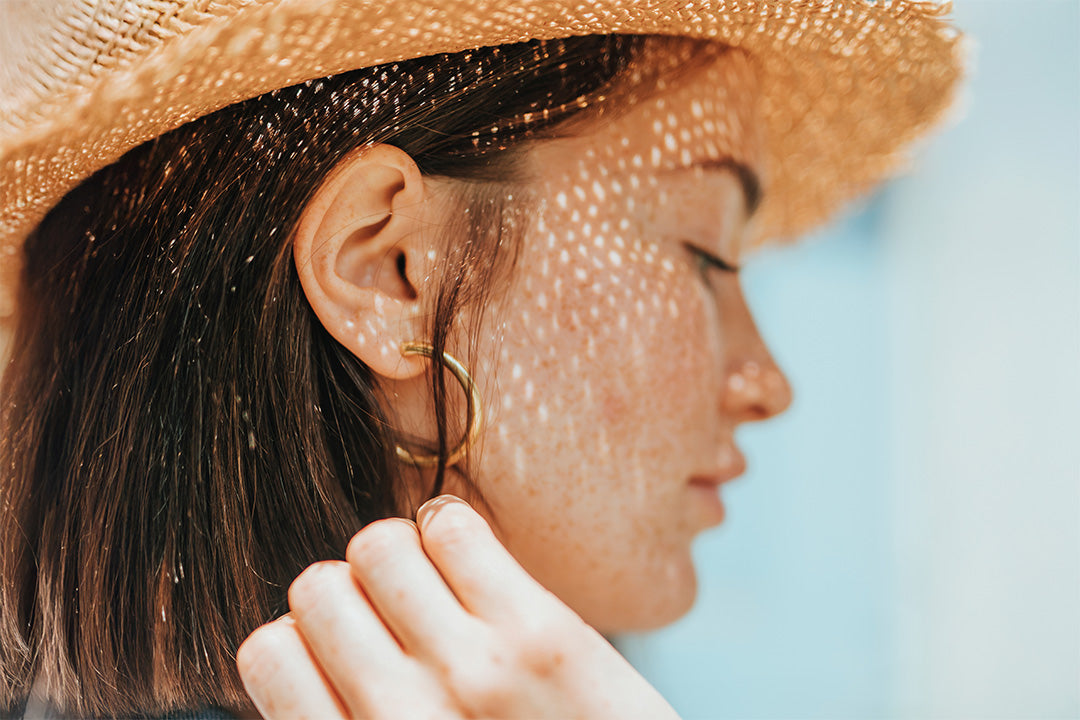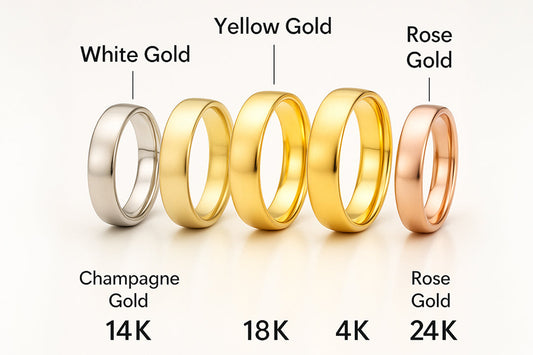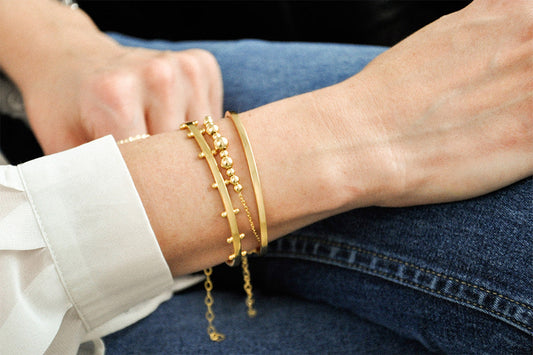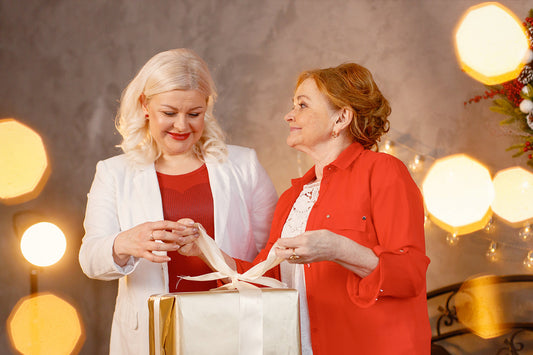
Which Jewelry Is Waterproof? A Guide to Wearing Gold, Gold Plated, and Vermeil Jewelry in Water
If you love wearing jewelry every day — even in the shower, at the beach, or while swimming — you’ve probably asked yourself: what jewelry is actually waterproof? While no piece of jewelry is completely immune to long-term water exposure, some materials hold up much better than others. Solid gold, for example, is one of the most water-resistant options, while gold plated or vermeil jewelry may be more sensitive depending on care and usage. In this guide, we’ll break down which types of jewelry can handle moisture, what to avoid, and how to keep your favorite pieces looking beautiful even when life gets a little wet.
Table of Content
What Does "Waterproof Jewelry" Really Mean?
Waterproof vs. Water-Resistant: What’s the Difference?
The term “waterproof” is often used loosely in the jewelry world — but technically, very few pieces are truly waterproof. Most jewelry falls under the category of water-resistant, meaning it can tolerate some water exposure without immediate damage. Waterproof implies total immunity to water-related effects, even with long-term or frequent contact — which isn’t realistic for most materials.
Water-resistant jewelry, on the other hand, is crafted to withstand occasional splashes, sweat, or brief submersion (like washing hands or light rain), especially if properly cared for. Understanding this distinction helps you manage expectations and care for your jewelry more mindfully.
Can Any Jewelry Truly Be Waterproof Long-Term?
In practical terms, solid gold (14K or 18K) comes closest to being waterproof. It doesn’t rust, corrode, or turn green, making it ideal for everyday wear — even in the shower or pool. However, even solid gold can lose its shine or accumulate residue if not cleaned regularly.
Other materials like gold plated or vermeil jewelry may resist water temporarily, but over time, their gold layer can wear off if exposed to frequent moisture. So while they might handle occasional contact, they’re not designed for prolonged water exposure.

Ultimately, when we talk about waterproof jewelry, we’re really referring to materials that are water-tolerant with care — not invincible. The key lies in knowing the material and treating it accordingly.
Is Gold Jewelry Waterproof?
Why Solid Gold Is the Best Option for Water Resistance
When it comes to water resistance, solid gold (typically 14K or 18K) is your most reliable option. Unlike plated or alloy-based pieces, solid gold doesn’t contain reactive metals that easily oxidize or corrode. This means you can wear a solid gold necklace, ring, or bracelet in the shower or while washing your hands without worrying about it turning green, tarnishing, or rubbing off.
The higher the karat, the purer the gold — but also the softer the metal. That’s why 14K and 18K solid gold offer a great balance between durability and water resistance. They hold up well to daily moisture and are perfect for those who don’t want to constantly remove their jewelry.

Can You Wear Solid Gold in the Shower or Pool?
Yes — but with a few caveats. While solid gold won’t rust or stain your skin, repeated exposure to water (especially with chlorine or salt) can dull its shine over time. This doesn’t damage the metal itself, but it can cause buildup of soap, oil, or chemical residue that affects the jewelry’s appearance.
Wearing solid gold in the shower is generally safe, but remove it before swimming in pools or oceans, where harsh chemicals and minerals may gradually wear down the polish. Regular cleaning with a soft cloth can help keep your solid gold pieces looking radiant for years — even with occasional water exposure.

Our Waterproof Products
What About Gold Plated and Vermeil Jewelry?
How Gold Plating Reacts to Water Over Time
Gold plated jewelry consists of a thin layer of gold bonded over a base metal — often sterling silver, brass, or copper. While the outer layer looks like real gold, it’s much more delicate. With frequent exposure to water, especially in showers or pools, this thin layer can begin to fade, peel, or tarnish over time.
Even if the jewelry doesn’t change color right away, repeated moisture weakens the bond between the gold and the base metal underneath. Once that layer wears down, the underlying material becomes exposed — and that’s when you might see green stains or discoloration, particularly if the base is not sterling silver.
In short, gold plated jewelry is not waterproof, but it can be water-resistant to a degree — especially if you limit exposure and care for it properly.
How Vermeil Differs from Standard Gold Plated Jewelry
While both gold plated and gold vermeil jewelry have a golden finish, they’re not created equal — especially when it comes to durability and water exposure. The biggest difference lies in the materials and craftsmanship.
Gold vermeil is made by coating a base of sterling silver with a thick layer of real gold — either 14K or 18K. This not only gives it a premium look, but also enhances the piece’s resistance to everyday wear and tear. Vermeil jewelry stands up better to moisture and time compared to standard gold plated jewelry, which is often applied over cheaper base metals like brass or copper.

How Water Exposure Affects Jewelry Over Time
The Impact of Moisture, Soap, and Chlorine
Water alone isn’t always the enemy — but what’s in the water can seriously affect your jewelry. Everyday exposure to moisture, combined with elements like soap, shampoo, chlorine, and salt, can gradually degrade the surface of your pieces. These substances leave behind residues that dull the shine of gold, cause metal fatigue, and may even break down plating over time.
Chlorine in pools and cleaning products is especially harsh. It can erode finishes, weaken clasps, and cause discoloration — even in higher-end jewelry. And while solid gold resists corrosion, it’s not immune to losing its luster from repeated chemical exposure.

Common Signs of Water Damage in Jewelry
Over time, jewelry that’s been frequently exposed to water may show some visible signs of distress. These include:
Fading or dullness of the gold surface
Discoloration (such as green or black marks), especially on skin-contact points
Flaking or patchiness in gold plated pieces
Stiff or weakened chains and clasps
In vermeil and plated pieces, the gold finish may wear down, revealing the metal underneath. While this doesn’t happen overnight, it can accelerate if jewelry isn’t dried properly or if it's worn in the shower, pool, or sea on a regular basis.
Recognizing these signs early and taking proactive care steps (which we’ll cover next) can significantly extend the life and beauty of your jewelry.
Can You Shower or Swim with Waterproof Jewelry?
Safe Jewelry Types for Everyday Water Exposure
If you’re looking for jewelry that can handle daily moisture — like washing hands, getting caught in the rain, or even the occasional shower — your best bet is solid gold. Both 14K and 18K solid gold are non-reactive and won’t rust, tarnish, or turn your skin green. That makes them ideal for those who want low-maintenance, long-lasting pieces they don’t have to constantly remove.

Gold vermeil jewelry, while not as water-resistant as solid gold, holds up better than standard gold plated pieces thanks to its sterling silver base and premium gold coating. If you do get your vermeil jewelry wet occasionally, it’s unlikely to suffer immediate damage — but consistent exposure should still be avoided for long-term shine.
When to Take Your Jewelry Off and Why
Even with higher-quality materials, certain water-related situations call for extra caution. You should remove all jewelry — including solid gold — before:
Swimming in chlorinated pools or saltwater
Using cleaning products or harsh chemicals
Taking hot showers with steam and soap buildup
Applying lotions, perfumes, or oils directly on your skin
These environments can cause more than just surface wear — they can weaken chains, loosen clasps, or gradually erode delicate finishes. The takeaway? If you want your jewelry to look as good in two years as it does today, it’s worth removing it when in doubt.
How to Care for Your Jewelry After Water Exposure
Cleaning and Drying Tips for Long-Lasting Shine
If your jewelry gets wet — whether accidentally or during daily use — a few simple steps can help maintain its shine and integrity. First, gently pat the piece dry with a soft, lint-free cloth. Avoid rubbing aggressively, especially on gold plated or vermeil pieces, as this can wear down the finish.
For deeper cleaning, use lukewarm water and a mild, non-abrasive soap. Let the jewelry soak for a few minutes, then rinse and dry thoroughly. Never use harsh chemicals, jewelry dips, or ultrasonic cleaners on plated or vermeil jewelry, as they can strip the gold layer or damage the silver underneath.
Storage Habits That Prevent Moisture Damage
How you store your jewelry plays a huge role in preventing water-related wear. Always keep your pieces in a dry, cool environment — ideally in a fabric-lined jewelry box or soft pouch. To avoid scratches and tarnishing, store each item separately.
Adding a silica gel packet or an anti-tarnish strip can help absorb excess moisture, especially in humid climates or bathrooms. If you’ve worn your jewelry in a damp setting (like a beach vacation), be sure to clean and dry it fully before packing or storing it away.
A little care goes a long way — and with the right habits, your jewelry can stay beautiful for years, even with occasional water exposure.






